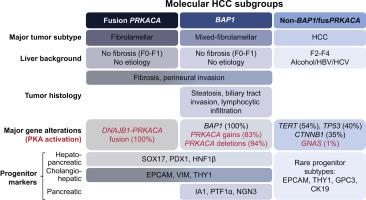当前位置:
X-MOL 学术
›
J. Hepatol.
›
论文详情
Our official English website, www.x-mol.net, welcomes your
feedback! (Note: you will need to create a separate account there.)
BAP1 mutations define a homogeneous subgroup of hepatocellular carcinoma with fibrolamellar-like features and activated PKA
Journal of Hepatology ( IF 26.8 ) Pub Date : 2020-05-01 , DOI: 10.1016/j.jhep.2019.12.006 Théo Z Hirsch 1 , Ana Negulescu 1 , Barkha Gupta 1 , Stefano Caruso 1 , Bénédicte Noblet 1 , Gabrielle Couchy 1 , Quentin Bayard 1 , Léa Meunier 1 , Guillaume Morcrette 2 , Jean-Yves Scoazec 3 , Jean-Frédéric Blanc 4 , Giuliana Amaddeo 5 , Jean-Charles Nault 6 , Paulette Bioulac-Sage 7 , Marianne Ziol 8 , Aurélie Beaufrère 9 , Valérie Paradis 10 , Julien Calderaro 11 , Sandrine Imbeaud 1 , Jessica Zucman-Rossi 12
Journal of Hepatology ( IF 26.8 ) Pub Date : 2020-05-01 , DOI: 10.1016/j.jhep.2019.12.006 Théo Z Hirsch 1 , Ana Negulescu 1 , Barkha Gupta 1 , Stefano Caruso 1 , Bénédicte Noblet 1 , Gabrielle Couchy 1 , Quentin Bayard 1 , Léa Meunier 1 , Guillaume Morcrette 2 , Jean-Yves Scoazec 3 , Jean-Frédéric Blanc 4 , Giuliana Amaddeo 5 , Jean-Charles Nault 6 , Paulette Bioulac-Sage 7 , Marianne Ziol 8 , Aurélie Beaufrère 9 , Valérie Paradis 10 , Julien Calderaro 11 , Sandrine Imbeaud 1 , Jessica Zucman-Rossi 12
Affiliation

|
BACKGROUND AND AIMS
DNAJB1-PRKACA fusion is a specific driver event in fibrolamellar carcinoma (FLC), a rare subtype of hepatocellular carcinoma (HCC) occurring in adolescents and young adults. In older patients, molecular determinants of HCC with mixed histological features of HCC and FLC (mixed-FLC/HCC) remain to be discovered. METHODS
A series of 151 liver tumors including 126 HCC, 15 FLC, and 10 mixed-FLC/HCC were analyzed by RNAseq and whole-genome- or whole-exome-sequencing. Western-blots were performed to validate genomics discoveries. Results were validated using the TCGA database. RESULTS
Most of the mixed-FLC/HCC RNAseq clustered in a robust subgroup of 17 tumors all showing mutation or translocation inactivating BAP1 that codes for the BRCA1 associated protein-1. Similar to FLC, BAP1-HCC were significantly enriched in female, tumor fibrosis and the lack of chronic liver disease when compared to non-BAP1-HCC. However, patients were older and with a poorer prognosis than FLC patients. BAP1 tumors were immune hot, showed progenitor features, did not show DNAJB1-PRKACA fusion and were almost all non-mutated for CTNNB1, TP53 and TERT promoter. In contrast, 80% of the BAP1 tumors showed a chromosome gain of PRKACA at 19p13, combined with a loss of PRKAR2A (coding for the inhibitory regulatory subunit of PKA) at 3p21, leading to a high PRKACA/PRKAR2A ratio at the mRNA and protein levels. CONCLUSION
We have characterized a subgroup of BAP1-driven HCC bearing fibrolamellar-like features and a dysregulation of the PKA pathway, which could be at the root of the clinical and histological similarities between BAP1 tumors and DNAJB1-PRKACA FLCs.
中文翻译:

BAP1 突变定义了具有纤维板层样特征和活化 PKA 的同质肝细胞癌亚组
背景和目的 DNAJB1-PRKACA 融合是纤维板层癌 (FLC) 的特定驱动事件,FLC 是一种罕见的肝细胞癌 (HCC) 亚型,发生在青少年和年轻人中。在老年患者中,具有 HCC 和 FLC(混合 FLC/HCC)混合组织学特征的 HCC 的分子决定因素仍有待发现。方法 通过 RNAseq 和全基因组或全外显子组测序分析了一系列 151 例肝脏肿瘤,包括 126 例 HCC、15 例 FLC 和 10 例混合 FLC/HCC。进行蛋白质印迹以验证基因组学发现。使用 TCGA 数据库验证结果。结果 大多数混合 FLC/HCC RNAseq 聚集在一个由 17 个肿瘤组成的强大亚组中,所有肿瘤都显示出突变或易位使编码 BRCA1 相关蛋白 1 的 BAP1 失活。与 FLC 相似,BAP1-HCC 在女性中显着富集,与非 BAP1-HCC 相比,肿瘤纤维化和慢性肝病的缺乏。然而,与 FLC 患者相比,患者年龄较大且预后较差。BAP1 肿瘤是免疫热的,表现出祖细胞特征,没有表现出 DNAJB1-PRKACA 融合,并且几乎都没有 CTNNB1、TP53 和 TERT 启动子的突变。相比之下,80% 的 BAP1 肿瘤在 19p13 显示 PRKACA 染色体增加,同时在 3p21 丢失 PRKAR2A(编码 PKA 的抑制性调节亚基),导致 mRNA 和蛋白质的 PRKACA/PRKAR2A 比率高水平。结论 我们已经表征了 BAP1 驱动的 HCC 亚组,具有纤维板层样特征和 PKA 通路失调,这可能是 BAP1 肿瘤和 DNAJB1-PRKACA FLC 之间临床和组织学相似性的根源。
更新日期:2020-05-01
中文翻译:

BAP1 突变定义了具有纤维板层样特征和活化 PKA 的同质肝细胞癌亚组
背景和目的 DNAJB1-PRKACA 融合是纤维板层癌 (FLC) 的特定驱动事件,FLC 是一种罕见的肝细胞癌 (HCC) 亚型,发生在青少年和年轻人中。在老年患者中,具有 HCC 和 FLC(混合 FLC/HCC)混合组织学特征的 HCC 的分子决定因素仍有待发现。方法 通过 RNAseq 和全基因组或全外显子组测序分析了一系列 151 例肝脏肿瘤,包括 126 例 HCC、15 例 FLC 和 10 例混合 FLC/HCC。进行蛋白质印迹以验证基因组学发现。使用 TCGA 数据库验证结果。结果 大多数混合 FLC/HCC RNAseq 聚集在一个由 17 个肿瘤组成的强大亚组中,所有肿瘤都显示出突变或易位使编码 BRCA1 相关蛋白 1 的 BAP1 失活。与 FLC 相似,BAP1-HCC 在女性中显着富集,与非 BAP1-HCC 相比,肿瘤纤维化和慢性肝病的缺乏。然而,与 FLC 患者相比,患者年龄较大且预后较差。BAP1 肿瘤是免疫热的,表现出祖细胞特征,没有表现出 DNAJB1-PRKACA 融合,并且几乎都没有 CTNNB1、TP53 和 TERT 启动子的突变。相比之下,80% 的 BAP1 肿瘤在 19p13 显示 PRKACA 染色体增加,同时在 3p21 丢失 PRKAR2A(编码 PKA 的抑制性调节亚基),导致 mRNA 和蛋白质的 PRKACA/PRKAR2A 比率高水平。结论 我们已经表征了 BAP1 驱动的 HCC 亚组,具有纤维板层样特征和 PKA 通路失调,这可能是 BAP1 肿瘤和 DNAJB1-PRKACA FLC 之间临床和组织学相似性的根源。











































 京公网安备 11010802027423号
京公网安备 11010802027423号